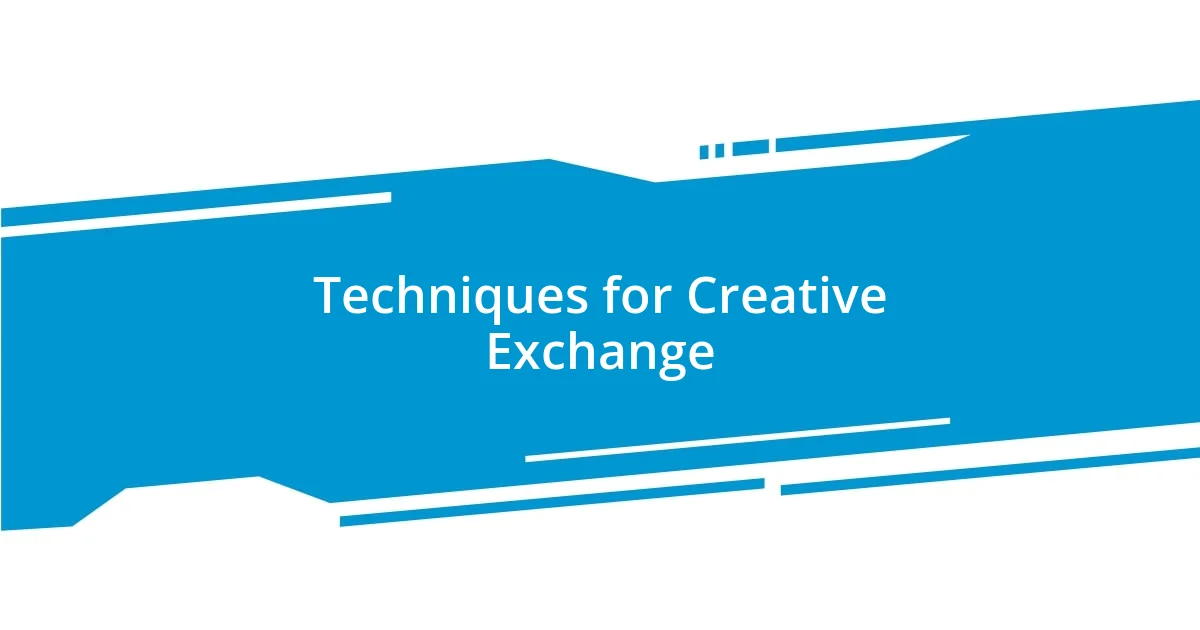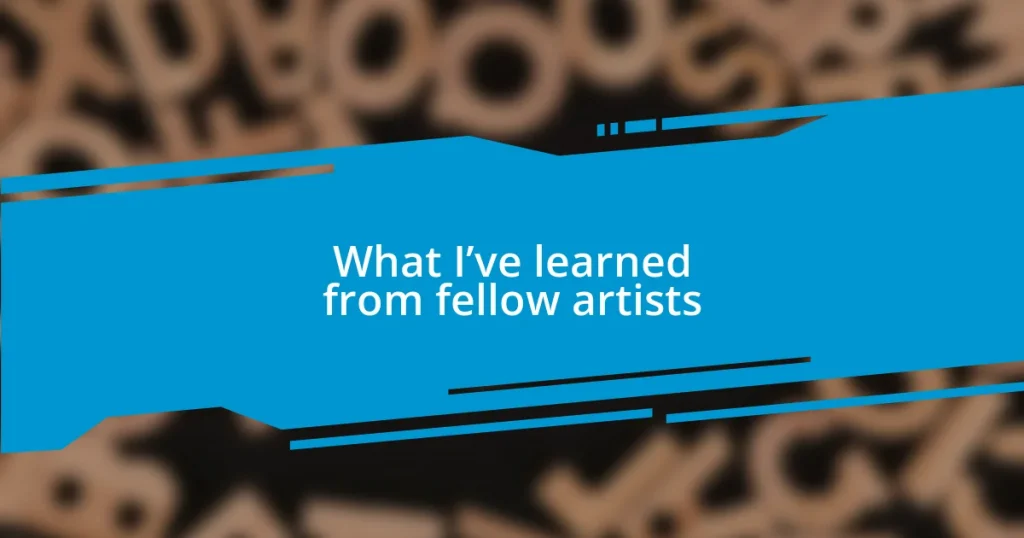Key takeaways:
- Collaboration with fellow artists fosters creativity and growth through shared experiences, vulnerability, and constructive feedback.
- Finding and engaging with an artistic community enhances personal and artistic development, providing support and inspiration.
- Applying insights gained from peers through experimentation and documentation leads to transformative improvements in artistic practice.

Influence of Fellow Artists
When I reflect on the influence of fellow artists, I can’t help but think of the countless late-night sessions spent with a close friend who creates stunning visual art. Watching them layer colors and textures taught me a great deal about the importance of experimentation in my own work. Have you ever felt that rush of creativity when surrounded by passionate peers? It’s exhilarating, and it’s a reminder that collaboration can spark new ideas in unexpected ways.
I recall a moment at an art fair when I struck up a conversation with a sculptor whose elegant pieces seemed to breathe life. They shared their journey of overcoming self-doubt, which resonated with my own struggles. It’s eye-opening how artists can uplift one another simply by sharing their vulnerabilities. Have you experienced a shift in perspective after hearing someone else’s story? I certainly have, and it often reignites my drive to create.
Another artist I met introduced me to the idea of embracing imperfections in our work. They would frequently say, “Mistakes are just the next step in the journey.” This shift in mindset has profoundly impacted how I approach my projects. Isn’t it freeing to think of our flaws as part of our unique expression? It’s friendships like these that light the way in our artistic endeavors.

Identifying Your Artistic Community
Identifying your artistic community is like finding a home where your creativity can thrive. I remember attending a local art workshop, feeling out of place initially. However, as I engaged with others, I discovered shared interests and passions. I connected with a group that values inclusivity and support, and it transformed my perspective on art-making. Isn’t it fascinating how a simple gathering can lead to creating meaningful bonds?
It’s important to be intentional in seeking out your community. Early on, I stumbled upon an online platform dedicated to artists in my niche. Joining forums and participating in discussions energized my creative process. I was amazed by how receiving feedback from like-minded artists helped me refine my craft. Have you ever sought validation from peers, only to find constructive criticism that genuinely helps? It’s a powerful reminder that our growth often lies in the eyes of those who share our journey.
Building and identifying your artistic community is an ongoing process. Recently, I’ve started co-hosting critique sessions, allowing me to connect with emerging artists. Watching them thrive has fueled my passion for collaboration and mentorship. It’s these interactions that shape not just my work, but my mindset as an artist. What about you? Have you found those who inspire and challenge you in your artistic path?
| Aspect | Self-Discovery |
|---|---|
| Impact of Community | Emotional Growth |
| Intentional Engagement | Creativity Boost |

Lessons in Collaboration and Feedback
Collaborating with fellow artists has taught me invaluable lessons about the power of feedback. I remember one particular group project where we created a mural. Each artist had a unique perspective, which made the final piece a beautiful tapestry of styles. It was during this process that I learned to accept, and even cherish, critiques. Those candid conversations and the willingness to learn from one another made me realize that constructive feedback is crucial for growth. It’s intriguing how sharing ideas can light up your vision and lead to unexpected outcomes.
Here are some key insights I’ve gathered from my experiences in collaborative environments:
- Embrace Vulnerability: Sharing your work can feel daunting, but it often leads to profound connections and insights.
- Mutual Growth: Every piece of feedback is an opportunity to learn. I’ve seen my art evolve simply by absorbing others’ perspectives.
- Active Listening: Engaging with others’ ideas allows your creativity to expand, pushing you beyond your comfort zone.
- Creating Safe Spaces: Establishing an environment where everyone feels comfortable sharing leads to deeper exploration of concepts and techniques.
- Appreciating Diverse Styles: Exposure to different artistic methods can inspire new directions in your own work.

Embracing Constructive Criticism
Embracing constructive criticism is like acquiring a new lens through which to view my art. I still vividly recall a critique session where I showcased a piece I had poured my heart into. The feedback initially stung, yet it sparked a lightbulb moment for me; the suggestions for improvement were not just critiques but invitations to explore new depths of creativity. Have you ever experienced that bittersweet realization that what feels like a critique is really a pathway to growth?
Every time I step into a critique circle, I remind myself that each comment is an opportunity to gain perspective. One artist pointed out how incorporating more color could convey emotion better in my piece. At first, I doubted it, but after revisiting my work with an open mind, I saw the potential. Isn’t it incredible how a simple observation can ignite a fresh approach to our creative expression?
Moreover, I’ve learned that embracing criticism isn’t just about accepting feedback; it’s about fostering a mindset of curiosity and openness. I’ve started journaling my thoughts after each critique, which has helped me process the advice and even track my evolution as an artist. Isn’t it fascinating how keeping a record can document not only artistic growth but also personal development?

Techniques for Creative Exchange
Exploring techniques for creative exchange has opened up a wealth of insights for me. One memorable experience was during a workshop where we were paired with artists from different disciplines. I found that simply observing how a dancer interpreted a theme inspired me to incorporate movement into my paintings. Isn’t it amazing how sharing our art can transcend mediums and enrich our individual processes?
Additionally, I’ve learned that holding informal “art jams” can be incredibly beneficial. These collaborative sessions allow us to spontaneously create together, fostering an environment where ideas flow unhindered. I remember one particular jam where we randomly exchanged sketches midway through the session; it was exhilarating to see how my style blended with another’s approach. That spontaneity sparked ideas I wouldn’t have considered on my own.
Lastly, engaging in regular discussions about techniques and inspirations can deepen our artistic connections. I often find that when I share the emotional triggers behind my work, others respond with their own stories. This kind of exchange not only creates bonds but brings forth new perspectives on our shared experiences. Have you experienced that moment when a simple conversation leads to a breakthrough in your own creative journey? It’s in those vulnerable dialogues that the magic truly happens.

Building Lasting Artistic Relationships
Building lasting artistic relationships has been one of the most rewarding aspects of my creative journey. I often recall a time I joined an artist collective; the camaraderie we built was truly special. Each member brought unique perspectives, and as we shared our works in progress, I felt a sense of belonging that pushed me to explore themes I had never considered before. Have you ever felt that sense of community that drives your creativity to new heights?
Trust is paramount in any artistic relationship. I remember collaborating with a fellow artist on a project where vulnerability was essential. We laid our ideas bare and encouraged each other to push boundaries. That openness transformed not just our work but also the respect we held for one another. Wouldn’t you agree that trusting another artist with your vision can be both daunting and liberating at the same time?
Moreover, I find that sharing experiences outside of art deepens these relationships. I recently attended a local gallery opening with fellow artists, and it turned into a heartwarming bonding experience. We exchanged stories about our failures and triumphs, which reinforced our connection. I realized that the closer we become as friends, the more we can nurture our creative paths together. Isn’t it intriguing how sharing personal experiences can make our collaborations more meaningful and enriching?

Turning Insights into Practice
Turning insights into practice often requires us to take tangible steps based on what we’ve learned from others. One afternoon, after a discussion about color theory with a fellow painter, I decided to challenge myself by using a completely different palette in my next piece. The result was striking—unexpected hues interacted in ways I never anticipated, making the canvas come alive. Have you ever experimented with an idea from someone else and found it transformed your work?
In another instance, after attending a local exhibition where various artists shared their techniques, I was particularly struck by how a printmaker approached texture. I went home and pulled out materials I hadn’t used in ages—things like sponges and old fabrics. It felt liberating to dive back into abstraction, weaving different textures into my paintings. Isn’t it fascinating how a single moment of inspiration can unlock a door to new techniques and ideas?
Documentation plays a crucial role in turning insights into practice. I’ve started keeping a visual journal where I jot down not just ideas, but also notes on conversations that sparked them. Last week, I wrote about a sculptor’s approach to form that resonated with me deeply. Reflecting on those conversations helps me continuously evolve my artistic voice. Have you considered how journaling your artistic interactions could impact your development as an artist?
















